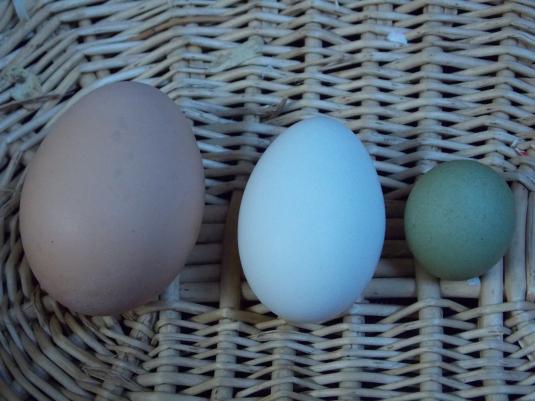Look what we recently found in our hen house!

The brown egg is from a standard layer, the white is from a bantam, and that little green marble is actually a new egg. It’s from a juvenile who is just starting to lay eggs (around these parts, tiny eggs are that are called “fart eggs.”) It’s perfectly normal, except that we’ve never had olive colored eggs before. (Going to have to dig up my edition of “Green Eggs and Ham.”)
The only culprits we can come up with are the Guinea hens (which have both proven to be females, thank God.) I got the Guineas as young juveniles in the late summer/early fall so the timing is just about right. From what I gather Guinea eggs are typically brown, but the color depends on the breed. I got my hens from a chicken swap and don’t know if they are pure-bred or are a mix, and if they are a mix, then olive eggs would be more than probable.
Guinea eggs are typically smaller than hen eggs (although not this small) and the rule of thumb is to use two Guinea eggs in place of one chicken egg. Some people swear by the flavor and insist that they are tastier than their chicken sisters’ counterparts. And speaking of tasty, although we are not going to eat our birds, by all accounts, Guineas have meat that is compared to Pheasant – I’m assuming that that means it’s a bit flavored and probably needs to be cooked longer.
On that point, however, I shall never know for certain.
Guineas also tend to lay eggs in a hidden corner or under a bush, as opposed to using a nesting box. If they free range, good luck finding their eggs. Not the smartest of birds, they nest on the ground and will lay up to 20 eggs in a clutch making things very easy for predators to snack on the eggs. Once the eggs hatch (if they hatch) Guineas are notorious for abandoning the nest – resulting in a very high mortality rate for the chicks.
Bottom line is that if you want to breed Guinea hens, you’ll have to secure them in a confined space or hatch the eggs by incubator.
None of this matters though I got the Guinea hens to help with tick control next summer. My plan was to keep them in the coop over the winter (thus ensuring they know it is “home”) with the intent that if they got away from the coop (we free range the birds during warm days) they would know where to return in the evening.
And if they do fly off to the woods, I’ll make sure they have access to food so they will stay local and still, hopefully, manage our ticks from a distance.

